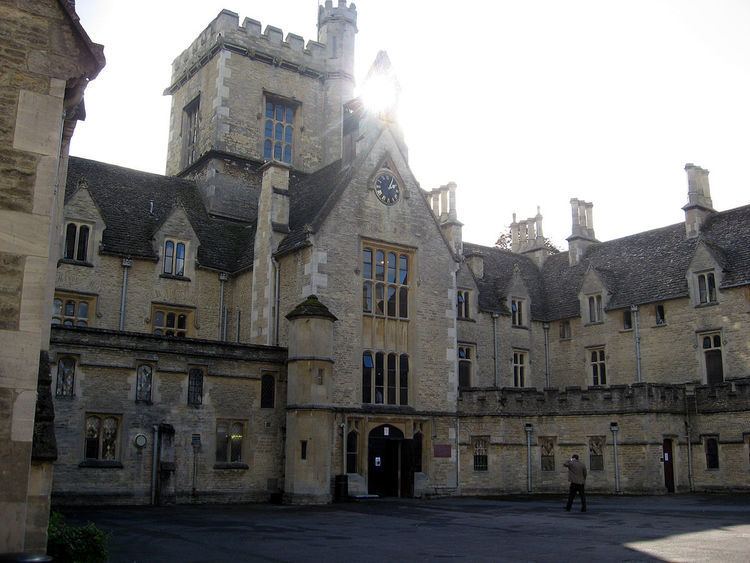Students 1,200 (2015/16) | Principal Professor Joanna Price Phone +44 1285 652531 | |
 | ||
Motto Latin: Avorum Cultus Pecorumque;(from Virgil's Georgics)"Caring for the Fieldsand the Beasts" Established 2013 - University status1845 - College President HRH The Prince of Wales Undergraduate tuition and fees Local tuition: 9,000 GBP (2016), International tuition: 10,000 GBP (2016) Notable alumni Profiles | ||
Mimi s graduation from the royal agricultural university cirencester
The Royal Agricultural University or RAU (previously known as the Royal Agricultural College or RAC) is a university located in Cirencester, Gloucestershire, UK. Established in 1845, it was the first agricultural college in the English-speaking world. The university provides more than 30 land-based undergraduate and postgraduate degree programmes to students from over 45 countries through the School of Agriculture, the School of Business and Entrepreneurship, the School of Equine and the School of Real Estate & Land Management.
Contents
- Mimi s graduation from the royal agricultural university cirencester
- History
- Facilities
- Farms
- Sport
- Research
- Library
- Staff
- Alumni
- References
History
The Royal Agricultural University was founded as the Royal Agricultural College in 1842, at a meeting of the Fairford and Cirencester Farmers’ Club. Concerned by the lack of government support for education, Robert Jeffreys-Brown addressed the meeting on "The Advantages of a Specific Education for Agricultural Pursuits". A prospectus was circulated, a general committee was appointed and Earl Bathurst was elected President. Funds were raised by public subscription: much of the support came from the wealthy landowners and farmers of the day, and there was no government support. The first 25 students were admitted to the College in September 1845.
Queen Victoria granted a Royal Charter to the College in 1845 and sovereigns have been patrons ever since, visiting the College in every reign. His Royal Highness the Prince of Wales became President in 1982.
The College gained full university status in 2013 and changed its name accordingly. It had 1,200 students in the 2015/16 academic year and saw a 49% rise in applications between 2008 and 2013. The Royal Agricultural University was named the safest university in the South West in 2013, and is ranked top in the UK for spending on facilities.
Facilities
Construction of the main building, in Victorian Tudor style, began in April 1845, was designed by SW Daukes and Hamilton, and built by Thomas Bridges of Cirencester.
Farms
The university operates two farms:
In 2011, an old sheep shed at the front of the farm complex was turned into the 'Rural Innovation Centre' a building designed for the training of students and members of the public in vocational skills such as rough-terrain forklift truck driving, blacksmithing, chainsaw and welding course, etc. The building cost £1.2 Million to transform. The RIC was officially opened in March 2014 by Sir John Beddington and the site was visited in November 2013 by HRH Prince Charles.
The university also uses numerous farms including a dairy enterprise at nearby Kemble Farms, and Fossehill Farm which provides stabling and exercise facilities. The RAU also uses numerous estates and businesses, both locally and further afield, for visits and practical exercises. Students have full access to the physical and financial data generated by the various enterprises and this is used in project work for a wide range of subjects, from practical livestock and 'crop husbandry', to conservation and farm woodland management, farm buildings, equine enterprise diversification, and rural business management.
Sport
The RAU is one of just three remaining British universities that maintains their own beagle pack. Founded in 1889, the RAC Beagles is run by the students, who whip in and hunt the hounds, and until the 2004 ban, hunted hares in the countryside around Cirencester.
The university has a range of sports facilities on campus; including a gym, an all-weather pitch, and squash and tennis courts, and offers a wide variety of sports and clubs for students to join; clay pigeon shooting, climbing, cricket, equestrian, football, golf, hockey, lacrosse, netball, polo, racing, rugby, running, sailing, scuba diving, ski and snow boarding, team chasing, tennis, and wakeboarding.
Research
In the REF 2014, the university came 29th and last in the UK for Agriculture. Some of the staff have been evaluated in the Research Assessment Exercise which recognised the importance of their research at national and, to a lesser extent, international levels.
Library
The university library holds around 40,000 print volumes, nearly 1,000 current journal subscriptions, more than 40,000 e-books and a growing number of full-text databases. The main collection is supplemented by a support collection and a historical collection of texts, primarily on agriculture and estate/land management, dating back to the 16th century. The library also holds the RAU archive, a collection of documents relating to the institution since its foundation.
Staff
James Buckman was professor of geology, botany, and zoology from 1848 to 1863.
John D. Custance was professor of agricultural science in the late 1870s, later was responsible for establishing Roseworthy Agricultural College in South Australia.
John Scott, on the staff shortly from 1880, later became known as a tractor pioneer.
Sir Emrys Jones, former chief adviser to the Minister of Agriculture from 1967 to 1973, and director of the Government's Agricultural and Development Advisory Service (ADAS), was Principal of the college from 1973 until 1978. He described his time at Cirencester as the most enjoyable period in his life In 2011, a new teaching facility at the college was named in his honour. For university applicants with a connection to Wales, a scholarship has been set up that carries the former principal's name.
Alumni
Royal Agricultural University graduates have won a number of awards and prizes, including the Farmers Weekly Young Farmer Of The Year Award (James Price 2009 and Adrian Ivory 2008).
Notable students from the institution include:
